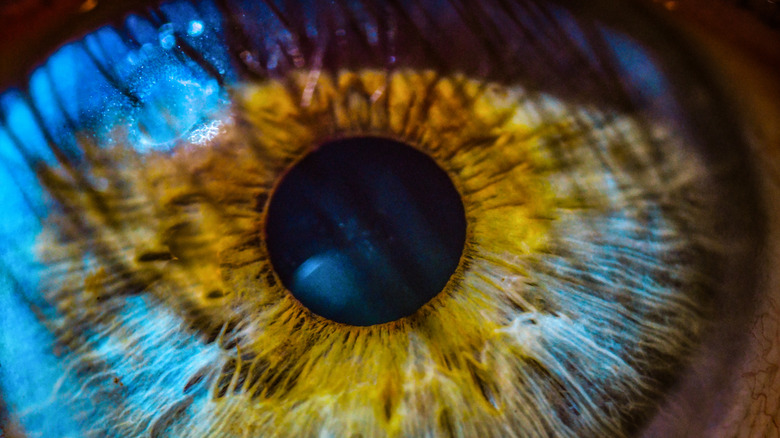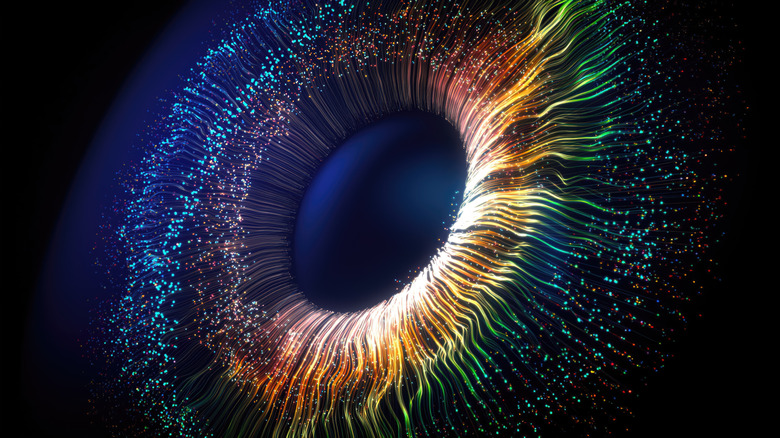What Do Totally Blind People See? It's Not What You Think
The question of what totally blind people see might seem like a simple one to answer, but things are a lot more nuanced than you'd expect. According to the National Library of Medicine, people with compromised sight can be broadly grouped into three categories: low vision, visual impairment, and blindness. There are roughly 15% of people with eye disorders that fall into the latter but even among those individuals there are gradations.
Most visually impaired individuals are able to see something and those with blindness are often capable of light perception. It's unknown exactly how many people are completely blind with absolutely no ability to perceive light, but it's thought that this applies to less than 10% of totally blind individuals.
As such, while our intuition might tell us that totally blind people would see only black, in much the same way as we see darkness when we close our eyes, this is a widespread misconception. The truth about what blind people see is actually a lot more complicated and a lot more interesting. Put simply, totally blind people don't actually see the color black, but what they do see depends on several factors.
Most visually impaired people can see something
Our vision involves the use of many organs. It works by light hitting the light-sensitive layer of tissue called the retina, which sits at the back of our eye. That light is then converted into electrical signals which travel to the brain via the optic nerve. There are several areas of the brain that make use of this converted light, most significantly the visual cortex which produces our conscious vision.
But if our vision is impaired, our ability to experience conscious vision in this way is affected. It's rare that the visual experience disappears completely, however. Those who experience blindness don't all suddenly find themselves plunged into perpetual blackness, but what they do experience varies dramatically between individuals.
As the American Foundation for the Blind notes, very few people are actually without sight completely; 85% of those with impaired vision retain some form of sight, whether that's basic light perception, blurry vision, an inability to see color, or a loss of peripheral vision. Total blindness, which involves the complete lack of light perception and form perception, affects around 15% of those with visual impairments. Even in these cases, however, individuals may still have the sensation of seeing things, but it depends on when and how they went blind.
What do totally blind people see?
If an individual goes totally blind without light perception, does that mean they live in a state of darkness? Put simply, no. Writing for the BBC, journalist Damon Rose recalled how he lost his sight as a child after surgery and was registered as completely blind with no light perception. But as Rose explains, he still has a visual experience in the form of "bright, colourful, ever-changing, often terribly distracting, light." But Rose isn't perceiving actual light in the world around him. Instead, as he put it, "it's my brain making up for the fact that it no longer receives any pictures."
But what about those born with total blindness? Well, they're unable to perceive the color black at all. After all, what is color to someone who has never seen it? Instead, it is a simple lack of any visual sense at all. Even then, however, research shows that blind people can understand color the same way sighted people do.
A 2021 study published in Psychological and Cognitive Sciences detailed an experiment involving both blind and sighted adults. The participants were asked questions about objects including fruits, plants, pens, and dollar bills among others. These questions pertained to the common color of objects, why they were that color, and whether participants thought two objects chosen at random would be the same color. Researchers found that while blind participants weren't always in agreement with their sighted counterparts on the actual color of objects, such as bananas being yellow, their reasoning about why those objects were a certain color and whether two objects were likely to be the same shade were identical to sighted people. This suggests that people develop what the team dubbed "theories" of color based on intuition regardless of their experience with sight. That's not to say that somebody who was born with total blindness would be able to visualize colors, but it does show that they're capable of understanding color on some level, rather than simply being entirely ignorant of such a concept.


